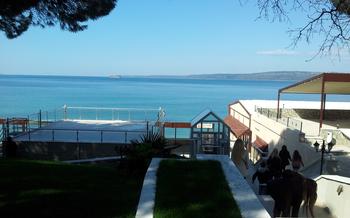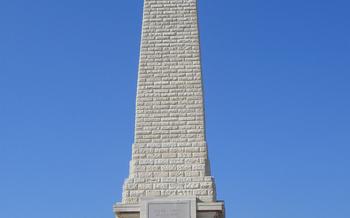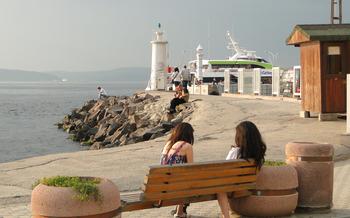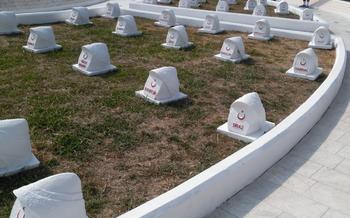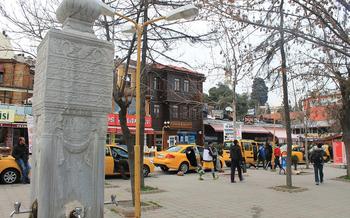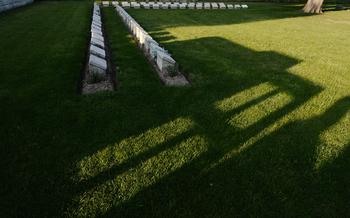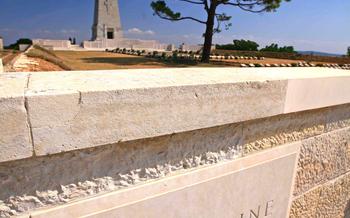
Gallipoli Film Set
- Historical Significance: Gallipoli's Enduring Legacy
- War Memorials and Cemeteries
- Gallipoli Museum: A Journey Through History
- Battlefields and Trenches
- Guided Tours: Unraveling the History of Gallipoli
- Beaches and Landscapes
- Accommodation and Dining
- Transportation
- Planning Your Visit
- Respecting the History
- Exploring Nearby Attractions
- Photography Tips
- Local Culture and Customs
- Insider Tip: Uncovering the Hidden Gem of Kabatepe
Historical Significance: Gallipoli's Enduring Legacy
The Gallipoli Peninsula, a narrow stretch of land jutting out into the Aegean Sea, bears witness to a pivotal chapter in world history. During World War I, this strategic location became the stage for one of the most harrowing campaigns, forever etching its name in the annals of military history. The Allied forces, comprising troops from Britain, France, Australia, New Zealand, and India, launched an ambitious amphibious assault on the peninsula in April 1915, aiming to capture Istanbul, the Ottoman Empire's capital. However, the Ottoman forces, led by Mustafa Kemal Atatürk, staged a fierce resistance, repelling the Allied advances and inflicting heavy casualties. The Gallipoli campaign dragged on for eight bloody months before the Allies were forced to withdraw in January 191This ill-fated campaign, often referred to as the "Dardanelles Campaign," resulted in a staggering loss of life on both sides, leaving an enduring legacy of sacrifice and heroism. The Gallipoli Peninsula now stands as a poignant reminder of the futility of war and the indomitable spirit of those who fought and perished on its shores.
War Memorials and Cemeteries
The Gallipoli Peninsula is dotted with war memorials and cemeteries that commemorate the soldiers who fought and died in the campaign. These memorials serve as a poignant reminder of the sacrifices made by soldiers from Turkey, Australia, New Zealand, and other nations.
One of the most significant memorials is the ANZAC Cove War Memorial, which honors the Australian and New Zealand soldiers who landed on the peninsula on April 25, 19The memorial features a bronze statue of a soldier standing atop a rocky outcrop, overlooking the beach where the ANZACs landed.
Another important memorial is the Çanakkale Martyrs' Memorial, which is dedicated to the Turkish soldiers who defended the peninsula. The memorial consists of a large obelisk surrounded by a park, offering a panoramic view of the Dardanelles Strait.
Visiting the war memorials and cemeteries in Gallipoli is a humbling experience that allows visitors to pay their respects to the fallen soldiers and learn more about the history of the campaign. The inscriptions on the memorials and headstones tell the stories of individual soldiers, providing a glimpse into their lives and the sacrifices they made.
Gallipoli Museum: A Journey Through History
The Gallipoli Museum is a treasure trove of knowledge and artifacts dedicated to preserving the memory of the Gallipoli campaign. Located in the heart of the peninsula, the museum offers an immersive experience that brings the history of this pivotal battle to life.
As you step inside, you'll be greeted by an array of exhibits that showcase a diverse collection of artifacts, documents, and photographs. These relics provide a tangible connection to the past, offering a glimpse into the lives of the soldiers who fought and died on these shores.
Interactive exhibits and multimedia presentations bring the history of the campaign to life, allowing visitors to experience the sights and sounds of the battlefield. You'll learn about the strategies and tactics employed by both sides, the challenges they faced, and the ultimate outcome of the campaign.
The museum also houses a research center dedicated to preserving and sharing the stories of the Gallipoli campaign. Here, scholars and researchers work tirelessly to uncover new insights and perspectives on this significant event.
Whether you're a history buff, a descendant of a soldier who fought in the campaign, or simply someone interested in learning more about this pivotal moment in world history, the Gallipoli Museum is a must-visit attraction. It's a place where the past comes alive, and the legacy of the Gallipoli campaign is honored and remembered.
Battlefields and Trenches
The Gallipoli Peninsula is home to some of the most well-preserved battlefields and trenches from World War I. Visitors can explore these sites and gain a glimpse into the harsh conditions faced by the soldiers who fought here.
The trenches are a particularly poignant reminder of the horrors of war. They are narrow, cramped, and often filled with water and mud. The soldiers who lived in these trenches were constantly under fire and had to endure the constant threat of death.
Some of the most famous battlefields on the peninsula include Chunuk Bair, Lone Pine, and Anzac Cove. These sites were the scene of some of the fiercest fighting during the campaign, and they are now home to war memorials and cemeteries that commemorate the soldiers who died here.
Visitors can explore the battlefields and trenches on their own or as part of a guided tour. Guided tours are a great way to learn more about the history of the campaign and to get a better understanding of the strategic significance of different battlefield locations.
Here are some tips for exploring the battlefields and trenches of the Gallipoli Peninsula:
- Wear comfortable shoes, as the terrain can be uneven and difficult to navigate.
- Bring plenty of water, as there are no water sources on the battlefields.
- Be respectful of the memorials and cemeteries, and avoid making noise or taking photos of people who are grieving.
- If you are visiting the battlefields in the summer, be aware that the weather can be very hot and dry.
Guided Tours: Unraveling the History of Gallipoli
Embark on a guided tour of the Gallipoli Peninsula to delve deeper into its rich history and significance. Choose from various tour options, including group tours led by experienced guides who provide insightful commentary and historical context. Private tours offer a personalized experience, allowing you to customize the itinerary based on your interests. For a more independent exploration, opt for self-guided tours with audio guides or downloadable apps that guide you through the peninsula's key landmarks.
A knowledgeable guide can bring the history of Gallipoli to life, sharing stories of the battles, the soldiers, and the impact of the campaign on the course of World War I. They can point out strategic locations, explain the significance of different memorials and cemeteries, and provide a deeper understanding of the events that unfolded on the peninsula.
Whether you prefer a group tour for a lively and interactive experience or a private tour for a more intimate and tailored exploration, booking a guided tour is an excellent way to gain a comprehensive understanding of the Gallipoli Peninsula and its fascinating history.
Beaches and Landscapes
The Gallipoli Peninsula offers a stunning contrast to its historical sites with its pristine beaches and breathtaking landscapes. The crystal-clear waters, sandy shores, and lush forests provide a serene escape from the poignant reminders of war. Visitors can immerse themselves in the natural beauty of the region by swimming, sunbathing, and hiking amidst the picturesque surroundings. Secluded beaches and scenic viewpoints await those willing to venture off the beaten path, offering tranquility and solitude. The Gallipoli Peninsula is a place where history and nature harmoniously coexist, inviting visitors to experience both the solemn and the serene aspects of this remarkable destination.
Accommodation and Dining
The Gallipoli Peninsula offers a range of accommodation options to suit every budget and preference. From budget-friendly hostels and guesthouses to comfortable hotels and luxurious resorts, there are plenty of places to stay in the area. For a truly immersive experience, consider staying in one of the historical guesthouses or boutique hotels that have been restored to reflect the region's rich heritage.
When it comes to dining, the Gallipoli Peninsula is a culinary paradise. Sample the freshest seafood at one of the many fish restaurants along the coast, or indulge in traditional Turkish cuisine at a local restaurant in the town of Çanakkale. Don't miss the opportunity to try regional delicacies such as grilled octopus, stuffed mussels, and the famous Çanakkale meatballs. For a sweet treat, try the traditional Turkish delight, a soft and chewy confection made with sugar, starch, and nuts.
Transportation
Getting to and around the Gallipoli Peninsula is relatively easy, with several transportation options available. Public transportation, including buses and ferries, is a convenient and affordable way to travel between major towns and cities in the region. For those who prefer the flexibility of exploring at their own pace, car rental services are widely available.
When navigating the peninsula's roads, be prepared for narrow and winding roads, especially in rural areas. Parking can be limited, particularly during peak tourist season, so it's advisable to plan your parking strategy in advance. To avoid any inconvenience, consider booking transportation in advance, especially for group tours or during special events.
For those arriving by air, the nearest airport is Çanakkale Airport (CKZ), located approximately 12 kilometers from the city center. From the airport, you can take a taxi or rent a car to reach your destination.
Planning Your Visit
When planning your visit to the Gallipoli Peninsula, meticulous preparation is essential, especially if your time is limited. To make the most of your trip, craft a detailed itinerary that encompasses all the must-see attractions and activities, taking into account the opening hours and travel distances between sites. Consider visiting during the shoulder seasons, spring or fall, to avoid the throngs of tourists and relish the more temperate weather. Be sure to pack suitable clothing for the anticipated weather conditions and the activities you plan to engage in.
Respecting the History
The Gallipoli Peninsula is a place of immense historical significance and a poignant reminder of the sacrifices made by soldiers from many nations during World War I. It is crucial for visitors to be respectful of the site's history and its role as a place of remembrance. This means being mindful of your behavior and actions while visiting war memorials and cemeteries. Avoid any disrespectful or disruptive activities, such as loud talking, laughing, or running. It is also essential to preserve the historical integrity of the site by refraining from touching or damaging any structures, artifacts, or memorials. By showing respect for the history and heritage of Gallipoli, visitors can contribute to its preservation and ensure that future generations can continue to learn from and honor the sacrifices made here.
A personal anecdote that highlights the significance of respecting the history of Gallipoli:
During my visit to the Gallipoli Peninsula, I was particularly moved by the stories of the soldiers who fought and died here. I remember standing at the ANZAC Cove War Memorial, reading the names of the fallen soldiers and trying to imagine the horrors they had experienced. It was a deeply emotional experience, and I couldn't help but feel a sense of awe and gratitude for their sacrifice. I realized that it was my responsibility as a visitor to treat this place with the utmost respect, to honor their memory, and to ensure that their stories are never forgotten.
Exploring Nearby Attractions
In addition to the Gallipoli Peninsula's historical significance, the region boasts a wealth of other captivating attractions that visitors should not miss. Embark on a journey to the ancient city of Troy, where legends and myths come to life. Explore the ruins of this once-mighty city, including the legendary walls and the site where the Trojan Horse is said to have entered.
Discover the archaeological wonders of Assos, an ancient port city perched on a picturesque hilltop. Admire the well-preserved ruins of the ancient theater, agora, and temple of Athena, which offer a glimpse into the city's glorious past.
Venture to the charming town of Ayvalık, a vibrant seaside destination with a unique blend of Greek and Turkish influences. Stroll along the picturesque harbor, lined with colorful houses and traditional balıkçı teknesi (fishing boats). Savor the delicious local cuisine, known for its fresh seafood and olive oil dishes.
Each of these nearby attractions offers a unique perspective on the history and culture of the region, complementing the immersive experience of visiting the Gallipoli Peninsula.
Photography Tips
Capturing the beauty and significance of the Gallipoli Peninsula through photography is a rewarding experience. Here are some tips for taking stunning photographs:
-
Golden Hours: The best time to photograph the Gallipoli Peninsula is during the golden hours, which are just after sunrise and just before sunset. The warm, diffused light during these times creates a magical atmosphere and enhances the colors of the landscapes and historical sites.
-
Tripod and Settings: Use a tripod to stabilize your camera and ensure sharp images, especially when shooting in low-light conditions. Experiment with different camera settings, such as aperture, shutter speed, and ISO, to achieve the desired depth of field and exposure.
-
Composition: Pay attention to composition to create visually appealing photographs. Look for leading lines, such as roads or trenches, that draw the viewer's eye into the image. Incorporate elements of the landscape, such as trees, hills, or the sea, to add depth and context to your photos.
-
Wildlife Encounters: The Gallipoli Peninsula is home to a variety of wildlife, including birds, reptiles, and mammals. Be patient and observant to capture candid shots of animals in their natural habitats. Use a telephoto lens to get closer to your subjects without disturbing them.
Local Culture and Customs
The Gallipoli Peninsula is a region rich in history and culture, and its people are known for their warmth and hospitality. When visiting the peninsula, it is important to be respectful of local customs and traditions. This includes dressing modestly, greeting people politely, and avoiding any disrespectful or disruptive behavior. Interacting with locals is a great way to learn about their experiences and perspectives on the history and culture of the region. Visitors will find that the people of Gallipoli are proud of their heritage and are eager to share their stories. Whether it's chatting with a shopkeeper, dining at a local restaurant, or joining a guided tour, engaging with locals can provide a deeper understanding of the region and its people.
Insider Tip: Uncovering the Hidden Gem of Kabatepe
Beyond the well-known historical sites of the Gallipoli Peninsula, lies a hidden gem waiting to be discovered - the charming village of Kabatepe. Nestled along the Aegean coastline, Kabatepe offers a unique blend of history, natural beauty, and authentic Turkish culture.
Stroll through the narrow cobblestone streets of Kabatepe and admire the traditional Ottoman-style houses, each with its own unique story to tell. Visit the local mosque, a testament to the village's deep-rooted Islamic heritage.
But the true magic of Kabatepe lies in its breathtaking natural surroundings. Hike along the scenic coastal paths, taking in panoramic views of the Aegean Sea and the distant islands. Discover hidden coves and secluded beaches, perfect for swimming, sunbathing, or simply relaxing in the tranquility of nature.
For a taste of authentic Turkish cuisine, savor the delicious seafood dishes at one of the local restaurants, where you can enjoy freshly caught fish and traditional meze platters while overlooking the sparkling waters of the Aegean.
Kabatepe is a place where time seems to stand still, allowing visitors to immerse themselves in the rich history and culture of the Gallipoli Peninsula while experiencing the warmth and hospitality of the local people.
To get to Kabatepe, take a short bus ride from the town of Eceabat or hire a car for a scenic drive along the coast. Remember to plan your visit during the shoulder seasons (spring or fall) to avoid the summer crowds and enjoy the village at its most serene.
